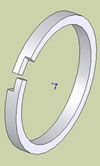Turbo oil seals
 If a shaft spinning at 20,000 rpm can pose a sealing problem then what about one doing 120,000 rpm or even, dare I say it, 240,000 rpm? A simple enough question, you might say, but before answering it we need to understand the application and the desired effectiveness of the seal required.
If a shaft spinning at 20,000 rpm can pose a sealing problem then what about one doing 120,000 rpm or even, dare I say it, 240,000 rpm? A simple enough question, you might say, but before answering it we need to understand the application and the desired effectiveness of the seal required.
A crankshaft oil seal for instance needs to be 100% reliable under all conditions. This is because in the mind of the customer, it takes but a single drop of oil to constitute a failure. In the case of a turbocharger however, the shaft seals are altogether a different proposition.
"Turbochargers are uncommonly leaky devices," claims one turbocharger manufacturer. Rather than the compressor intake air or exhaust turbine side of things, he was talking in particular about the bearing housing and the passage of air or exhaust gas into the bearing housing or lube oil in the other directions.
When a turbocharger is working as it should, the gas pressure immediately behind the turbine wheel or behind the turbo compressor should be higher than anything inside the bearing housing. Seals are therefore generally required at each end of the bearing housing, and normally take the form of simple steel piston rings in a grove at both the hot turbine end and cold compressor end of the shaft.
These rings expand outwards against the bearing housing and with such a snug fit do not rotate. Since they form a very close fit in the groove in the shaft, hot gas from the exhaust or cool intake air from the compressor is therefore prevented from entering the bearing housing.
In high-boost applications, air may leak into the bearing housing, but provided this is not too great it will mix with the oil-air mixture already present and drain back into the sump. At the hot turbine end, however, excessive gas leakage into the bearing housing will rapidly degrade the lube oil and result eventually in increased crankcase/sump pressure if not adequately vented.
Under other, often transient conditions, oil can leak into the turbine housing resulting in smoke, high oil consumption and generally messy oil streaks. The seal at the turbine end is therefore considered critical.
In the normal piston ring design a gap of 0.008-0.013 in (0.20-0.33 mm) is produced to allow thermal expansion at the turbine side as the temperature increases. Over time and as the ring wears, this gap will steadily increase, allowing oil to pass through the void where the two ends of the ring meet.
To combat this, two new configurations of this simple ring design have been produced. The first, a so-called stagger-gap arrangement, effectively replaces the standard ring with a version, which closes this gap using the stepped-end approach (see figure). A simple idea but presumably difficult to manufacture, this is sometimes called a 360º turbine oil seal.
The second, an even simpler idea in some ways, however, is to double the width of the ring groove and introduce two normal piston rings with ring gaps phased at 180º to each other. Supplied for high-performance turbines, where high engine oil pressures could introduce oil pullover, this approach is surprisingly effective and uses standard low-cost piston rings.
So while turbochargers might still be regarded as uncommonly 'leaky' in some ways, it is not for the lack of sealing options.
Fig. 1 - The stagger-gap oil seal
Written by John Coxon